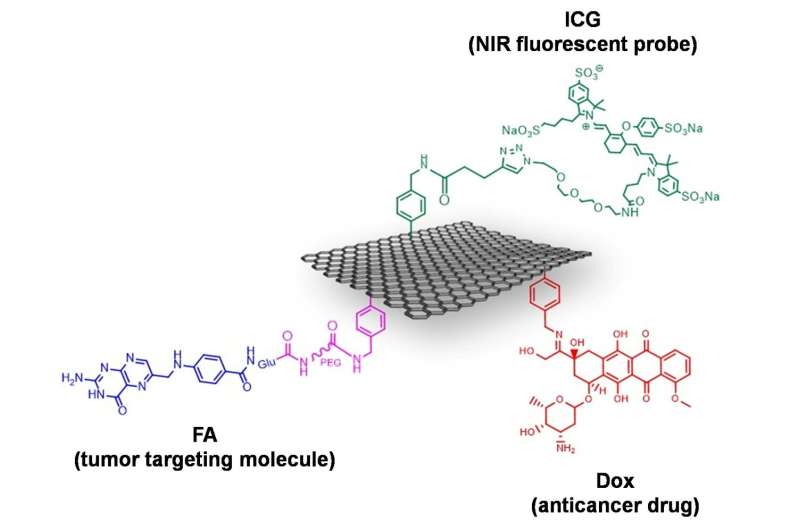Multi-functionalization of graphene for molecular targeted cancer therapy

Three functional molecules (near-infrared fluorescent probe, tumor targeting molecule, and an anticancer drug) are successfully decollated onto the surface of a graphene molecule. This multi-functional graphene allows effective cancer cell elimination. For fighting off cancerous diseases, this "triple" chemical modified nanomaterial might save the patient.
Cancer is a leading cause of death worldwide. Under this situation, a successful tumor selective drug targeting and minimizing toxicity of cancer drug are urgently necessary.
Scientists from Japan Advanced Institute of Science and Technology (JAIST) and Centre national de la recherche scientifique (CNRS), and their colleagues have developed a type of nanomedicine based on multi-functional graphene that allows for targeted cancer treatment at the molecular level.
Single molecular sheet graphene is a promising carbon nanomaterial for various fundamental and practical applications in the next decade because of its excellent physico-chemical features. Graphene has been also known to have a good biocompatibility and biodegradability, thus leading researchers to explore this nanocarbon as drug delivery carrier. However, it is not easy to modify many individual functional molecules onto a graphene nano-sheet at the same time for biomedical applications.
Developed by Prof. Eijiro Miyako from JAIST (Nomi, Japan), Dr. Alberto Bianco from CNRS (Strasbourg, France), and their international teams, the multi-functional graphene as a drug delivery carrier is successfully synthesized with three types of molecules: a near-infrared (NIR) fluorescent probe (indocyanine green; ICG); a tumor targeting molecule (Folic acid: FA); and an anticancer drug (doxorubicin; Dox) by a covalent chemical modification technique. ICG (the green part in the figure) was chosen as a fluorophore to follow the uptake and to track the material inside the cells. FA (blue) was covalently bound through polyethylene glycol (pink) linked to graphene, to specifically target the cancer cells; and Dox (red) was used as an anticancer drug.
After testing the therapeutic potential to eliminate cancer cells in a culture dish the team found that the unique properties of this multi-functional graphene material showed an enhanced anticancer activity with excellent cancer targeting effect. This may open doors to future biomedical applications of this type of material. The team plans to continue exploring multi-functional graphene towards the cancer therapy using murine animal model.
More information: Matteo Andrea Lucherelli et al, Rational chemical multifunctionalization of graphene interface enhances targeting cancer therapy, Angewandte Chemie International Edition (2020). DOI: 10.1002/anie.201916112
Journal information: Angewandte Chemie International Edition
Provided by Japan Advanced Institute of Science and Technology




















